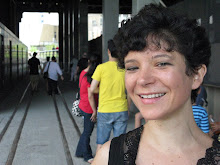Ruth Rootberg's article powerfully describes the benefits of consciously changing neuro-muscular patterns, even with a debilitating illness like Parkinson's. I have done some editing here, just for space factor. The whole study can be found at www.amsatonline.org in the latest edition of AmSAT News.
*****
The Alexander Technique and Parkinson's Disease: A Case Study in Generating Hope for a Degenerative Condition
The entire Summer 2010 issue of AmSAT News is now available in our bookstore.
The Alexander Technique and Parkinson's Disease:
A Case Study in Generating Hope for a Degenerative Condition
by Ruth Rootberg
In the summer of 2008 a student of mine who is a physician urged me to see her patient, "Sabrina" (fictitious name), a senior citizen with Parkinson’s disease. The physician was concerned because Sabrina’s breathing was becoming compromised as her chest increasingly collapsed downward. I agreed to see Sabrina to discuss what the Alexander Technique might offer her and under what circumstances we could arrange lessons. I was both curious and terrified about teaching her to re-coordinate neuro-muscular patterning while her nervous system was progressively deteriorating. How could I help her, and for how long? Before meeting Sabrina, I did some research.
Parkinson’s Disease
Parkinson’s Disease is a progressive, neurodegenerative movement disorder with symptoms that may include trembling in the hands, arms, legs, jaw, and face (tremor), rigidity and stiffness, slowness of movement, difficulty in initiating movement, and postural instability (impaired balance).1 Parkinson’s patients typically develop a stooped, head-down, shoulders-drooped stance with a tendency to lean unnaturally forward or backward, and they tend to walk with a distinctive unsteady shuffling gait.2 Parkinson's is generally considered a disease of late middle age with the average age of onset at around 60 years of age.3 Idiopathic Parkinson's disease is the most common form; it is called idiopathic because the cause for the condition is unknown.4
There is no known cure for Parkinson’s disease. Medical treatment involves powerful medications that act to reduce the symptoms and hopefully slow the pace at which the disease progresses. These powerful medications may produce unwanted side-effects, however, so care is taken in regulating and changing dosages as conditions warrant.
Some Parkinson’s patients undergo “deep brain stimulation.”5 In patients with Parkinson's disease, nerve cells in this region degenerate, causing tremors, stiffness, slowed movement, and loss of coordination. During this surgical procedure, electrodes are implanted that deliver electrical impulses to the region in the center of the brain that controls and coordinates movement. Physical therapy treatment stresses increasing patients’ comfort level and ability to manage daily life activities independently. This is where the Alexander Technique comes in.
.... Participants described improvements in walking, speech, improved posture or balance, greater energy, reduced tremor, and reduced rigidity or muscle tension. Some reported reduced stress or greater composure. Fewer changed their medications during the intervention or the six months following.
*********
Until next time...hope you're all having a sweet sort of day. It's your day after all. So why not take just a sec and notice where you are in space? Are you pulling up? Falling down? Squeezing, holding and making yourself tense all around?
You have brains in your head.
You have feet in your shoes.
You can steer yourself in any direction you choose.
You're on your own.
And you know what you know.
You are the guy who'll decide where to go. ~
- Dr. Seuss
Happy days,
wendy
Subscribe to:
Post Comments (Atom)

No comments:
Post a Comment